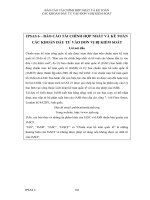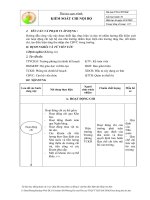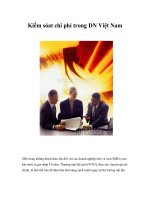ISA 9 kiểm tra kiểm soát
Bạn đang xem bản rút gọn của tài liệu. Xem và tải ngay bản đầy đủ của tài liệu tại đây (1007.73 KB, 41 trang )
Chapter 9
Tests of Controls
Copyright 2006 McGraw-Hill Australia Pty Ltd
Revised PPTs t/a Auditing and Assurance Services in Australia 3e by Grant Gay and Roger Simnett
Slides prepared by Roger Simnett
9-1
Learning Objective 1:
Tests of Controls
•
Provides auditor with evidence to support their
assessment of control risk. When control risk assessed
at less than high, necessary to gather evidence that
controls are working. This evidence is gathered via test
of controls.
• If control risk is assessed at high, auditor will not
undertake test of controls.
• Auditor selects most efficient and effective combination
of tests of controls, and substantive tests of
transactions and balances.
Copyright 2006 McGraw-Hill Australia Pty Ltd
Revised PPTs t/a Auditing and Assurance Services in Australia 3e by Grant Gay and Roger Simnett
Slides prepared by Roger Simnett
9-2
Assessing control risk
•
To assess control risk as high, auditor must expect that
substantive procedures alone will provide sufficient
appropriate evidence.
• Areas where substantive procedures alone may not
provide sufficient appropriate evidence include routine
recording of significant classes of transactions, such as
revenue or purchases. These areas often highly
automated with little or no manual intervention.
Copyright 2006 McGraw-Hill Australia Pty Ltd
Revised PPTs t/a Auditing and Assurance Services in Australia 3e by Grant Gay and Roger Simnett
Slides prepared by Roger Simnett
9-3
Planning the scope of tests of controls
•
•
•
•
Nature – if controls exist that the auditor expects to rely upon,
undertake tests of these controls, otherwise undertake
substantive testing.
Timing – to aid ability to meet deadlines and scheduling of
staff, tests of controls sometimes scheduled before year-end.
Testing then extended (rolled forward) until year-end.
Extent – the more the auditor relies on controls, the greater
the extent of tests of controls. For tests of controls related to
documents, extent determined by reference to sampling
theory.
Controls related to accounting routines (e.g. bank
reconciliations) usually tested by re-performing a small
number.
Copyright 2006 McGraw-Hill Australia Pty Ltd
Revised PPTs t/a Auditing and Assurance Services in Australia 3e by Grant Gay and Roger Simnett
Slides prepared by Roger Simnett
9-4
Learning Objective 2:
Existence, Effectiveness and Continuity of
Controls
•
For internal controls to provide audit evidence about risk
of material misstatements at the assertion level, the
auditor must collect audit evidence about the existence,
effectiveness and continuity of controls.
• Evidence of existence of controls is usually gained
when auditor is evaluating control risk.
• Tests of controls are aimed at establishing their
effectiveness and continuity.
Copyright 2006 McGraw-Hill Australia Pty Ltd
Revised PPTs t/a Auditing and Assurance Services in Australia 3e by Grant Gay and Roger Simnett
Slides prepared by Roger Simnett
9-5
Aspects of internal control
Copyright 2006 McGraw-Hill Australia Pty Ltd
Revised PPTs t/a Auditing and Assurance Services in Australia 3e by Grant Gay and Roger Simnett
Slides prepared by Roger Simnett
9-6
Learning Objective 3:
Sufficiency and Appropriateness
•
Dependent on the level of control risk the tests must
support.
• The lower the planned assessed level of control risk,
the greater the amount of testing that is required.
Copyright 2006 McGraw-Hill Australia Pty Ltd
Revised PPTs t/a Auditing and Assurance Services in Australia 3e by Grant Gay and Roger Simnett
Slides prepared by Roger Simnett
9-7
Others factors affecting sufficiency and
appropriateness
•
Auditor should also consider:
–
–
–
type and source of evidence
timeliness
interrelationship of evidence.
Copyright 2006 McGraw-Hill Australia Pty Ltd
Revised PPTs t/a Auditing and Assurance Services in Australia 3e by Grant Gay and Roger Simnett
Slides prepared by Roger Simnett
9-8
Effect of documentation of controls:
audit trail
•
Methods used by auditor is dependent on whether a
documentary audit trail exists.
• Where no audit trail exists, greater emphasis is placed
on:
–
–
•
observation
inquiry of the control.
If audit trail does exist:
–
Inspect documentation for evidence of the control.
Copyright 2006 McGraw-Hill Australia Pty Ltd
Revised PPTs t/a Auditing and Assurance Services in Australia 3e by Grant Gay and Roger Simnett
Slides prepared by Roger Simnett
9-9
Relationship between tests of controls
and assertions
•
When auditor’s assessment of material misstatement at
assertion level includes an expectation that controls are
operating effectively, the auditor should perform tests of
controls to obtain evidence that the controls were
operating effectively at relevant times during the audit.
• Controls that relate to the control environment of a
company’s internal control system relate less directly to
specific financial report assertions.
Copyright 2006 McGraw-Hill Australia Pty Ltd
Revised PPTs t/a Auditing and Assurance Services in Australia 3e by Grant Gay and Roger Simnett
Slides prepared by Roger Simnett
9-10
Assertions and testing control activities
•
The information system, control activities and monitoring of
controls are built around major flows of transactions and
events. Possible to relate most tests of controls for these
elements to assertions about classes of transactions and
events:
(i) Occurrence – transactions and events that have been recorded,
have occurred and pertain to the entity;
(ii) Completeness – all transactions and events that should have
been recorded have been recorded;
(iii) Accuracy – amounts and other data relating to recorded
transactions and events have been recorded appropriately
(iv) Cutoff – transactions and events have been recorded in the
correct accounting period; and
(v) Classification – transactions and events have been recorded in
the proper accounts.
Copyright 2006 McGraw-Hill Australia Pty Ltd
Revised PPTs t/a Auditing and Assurance Services in Australia 3e by Grant Gay and Roger Simnett
Slides prepared by Roger Simnett
9-11
Learning Objective 4:
Revenues, Receivables and Receipts
(Sales Cycle)
•
Sales cycle involves all those transactions and events
that are initiated when an entity makes a sale. It is
commonly characterised by a high volume of routine
transactions.
• Audit problems commonly related to clerical processing
rather than complex accounting problems.
Copyright 2006 McGraw-Hill Australia Pty Ltd
Revised PPTs t/a Auditing and Assurance Services in Australia 3e by Grant Gay and Roger Simnett
Slides prepared by Roger Simnett
9-12
Key functions in typical sales cycle
•
•
•
•
•
•
•
Order entry and order approval by credit department
Shipping
Invoicing
General ledger entry
Accounts receivable
Mail opening
Cashier functions.
Copyright 2006 McGraw-Hill Australia Pty Ltd
Revised PPTs t/a Auditing and Assurance Services in Australia 3e by Grant Gay and Roger Simnett
Slides prepared by Roger Simnett
9-13
Typical credit sales flowchart
Copyright 2006 McGraw-Hill Australia Pty Ltd
Revised PPTs t/a Auditing and Assurance Services in Australia 3e by Grant Gay and Roger Simnett
Slides prepared by Roger Simnett
9-14
Typical cash collection flowchart
Copyright 2006 McGraw-Hill Australia Pty Ltd
Revised PPTs t/a Auditing and Assurance Services in Australia 3e by Grant Gay and Roger Simnett
Slides prepared by Roger Simnett
9-15
Sales cycle — routine and non-routine
transactions
•
Routine transactions:
–
•
credit sales to customers, cash collections from
customers (flowcharts), usually strong control system,
auditor considers (and usually undertakes) tests of
controls.
Non-routine transactions:
–
adjustments to sales, and provisions for doubtful debts.
Less well controlled. Where material, auditor undertakes
substantive testing.
Copyright 2006 McGraw-Hill Australia Pty Ltd
Revised PPTs t/a Auditing and Assurance Services in Australia 3e by Grant Gay and Roger Simnett
Slides prepared by Roger Simnett
9-16
Control objectives for sales system
•
Controls are in place to ensure that:
–
–
–
–
–
Occurrence – all sales recorded are bona fide
transactions for merchandise actually shipped to
customers;
Completeness – all sales shipped are invoiced and
recorded in accounting records;
Accuracy – invoices have been recorded correctly as to
amount and summarised correctly;
Cutoff – invoices have been recorded in correct period;
Classification – sales classified in accordance with written
policies.
Copyright 2006 McGraw-Hill Australia Pty Ltd
Revised PPTs t/a Auditing and Assurance Services in Australia 3e by Grant Gay and Roger Simnett
Slides prepared by Roger Simnett
9-17
Example of linking objectives to control policies and
tests of controls for sales (Ref. Table 9.4 p. 411)
top of table 9.4
Special control
objectives
• Occurrence – All sales
recorded are bona fide
transactions for
merchandise actually
shipped to customers.
Common control
policies and
procedures
• Policy of authorisation
of credit and terms
• Evidence of quantities
shipped reconciled to
quantities invoiced
Tests of controls
• Select sample of sales
transactions from sales
journal (daily activity
report), check for
authorisation and trace
to shipping document
file
• Inspect reconciliation
of shipments to
invoices
Copyright 2006 McGraw-Hill Australia Pty Ltd
Revised PPTs t/a Auditing and Assurance Services in Australia 3e by Grant Gay and Roger Simnett
Slides prepared by Roger Simnett
9-18
Control objectives for cash receipt system
•
Controls are in place to ensure:
–
–
–
–
–
Occurrence – recorded cash receipts are for collection of
receivables resulting from sales to customers of the
entity;
Completeness – all cash receipts are recorded and
deposited;
Accuracy – cash receipts have been recorded correctly as
to amount;
Cutoff – cash receipts have been recorded in correct
period;
Classification – cash receipts are classified in accordance
with company policy.
Copyright 2006 McGraw-Hill Australia Pty Ltd
Revised PPTs t/a Auditing and Assurance Services in Australia 3e by Grant Gay and Roger Simnett
Slides prepared by Roger Simnett
9-19
Example of linking control objectives to control
policies to tests of controls: cash receipts (Ref.: Table
9.5 p. 413)
Special control
objectives
Common control
policies and
procedures
• Occurrence – Recorded
• Cash receipts matched
cash receipts are for
collection of receivables
resulting from sales to
customers of the entity.
to specific sales
invoices in posting to
accounts receivable
master file.
Test of controls
• Select a sample of
entries in cash receipts
journal and review
evidence that matched
to specific sales
invoices.
Copyright 2006 McGraw-Hill Australia Pty Ltd
Revised PPTs t/a Auditing and Assurance Services in Australia 3e by Grant Gay and Roger Simnett
Slides prepared by Roger Simnett
9-20
Types of misstatement in sales cycle
•
Generally result of:
–
–
–
–
clerical mistakes;
employee fraud;
misapplied accounting principles, especially around some
revenue recognition issues;
management fraud.
Copyright 2006 McGraw-Hill Australia Pty Ltd
Revised PPTs t/a Auditing and Assurance Services in Australia 3e by Grant Gay and Roger Simnett
Slides prepared by Roger Simnett
9-21
Learning Objective 5:
Expenditures, Payables and
Disbursements
•
Expenditure cycle — all transactions and events
initiated when an entity acquires assets or services
used for cash or credit.
• Auditors (and many entities) often separate this cycle
into a number of sub-cycles, which reflect various types
of services and assets that can be acquired.
Copyright 2006 McGraw-Hill Australia Pty Ltd
Revised PPTs t/a Auditing and Assurance Services in Australia 3e by Grant Gay and Roger Simnett
Slides prepared by Roger Simnett
9-22
Sub-cycles in expenditures,
payables and disbursements
•
These sub-cycles are:
–
–
–
–
–
–
payroll
property, plant and equipment
inventory
income taxes
selling and administrative expenses
miscellaneous expenses paid from petty cash.
Copyright 2006 McGraw-Hill Australia Pty Ltd
Revised PPTs t/a Auditing and Assurance Services in Australia 3e by Grant Gay and Roger Simnett
Slides prepared by Roger Simnett
9-23
Key functions within the inventory
sub-cycle
•
Purchasing
• Receiving
• Accounts payable
• Cash disbursements function.
Copyright 2006 McGraw-Hill Australia Pty Ltd
Revised PPTs t/a Auditing and Assurance Services in Australia 3e by Grant Gay and Roger Simnett
Slides prepared by Roger Simnett
9-24
Typical purchases and cash payments
flowchart
Copyright 2006 McGraw-Hill Australia Pty Ltd
Revised PPTs t/a Auditing and Assurance Services in Australia 3e by Grant Gay and Roger Simnett
Slides prepared by Roger Simnett
9-25









